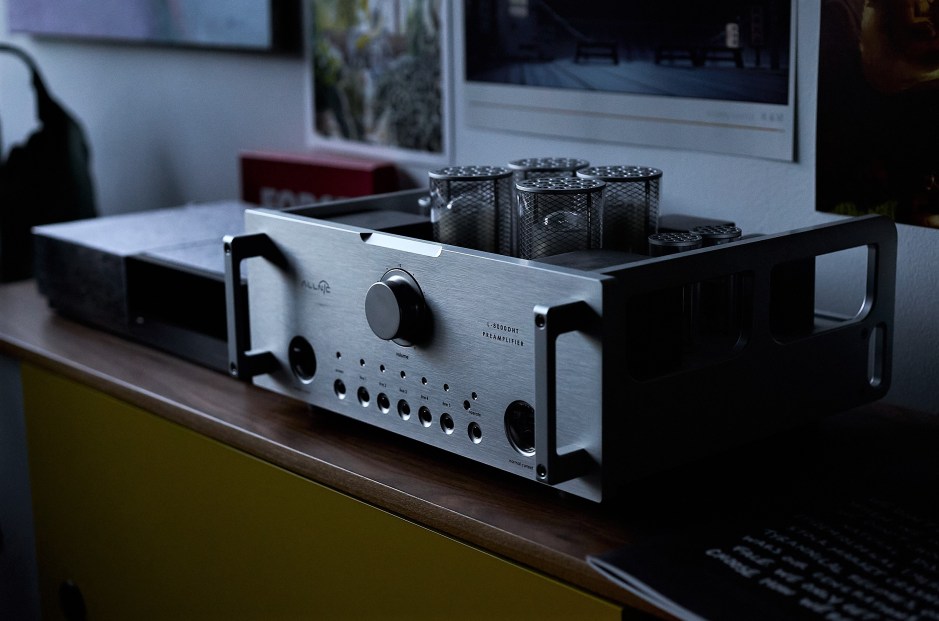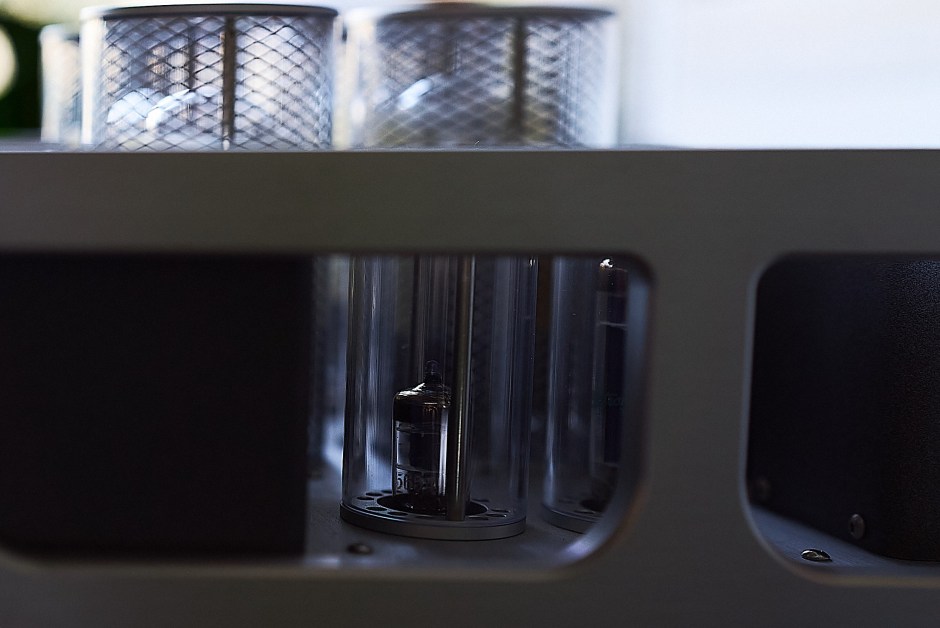
DHT is a magic three-letter acronym that speaks volumes to those in the know, especially when it comes to audio history and tubes. Before I get to the product at hand, the mysterious and magical Allnic Audio L-8000 DHT preamp, I’d like to take a moment to spotlight some of the acronyms behind this review.
DHTs, as mentioned above, stands for Directly Heated Triodes, which are the very first tube type to have been invented. They are simply an anode, cathode and grid in a vacuum sealed glass bottle. Pretty straightforward, but what might convince an engineer to return to this earliest and apparently crudest of signal amplification technologies? One of the keys lies in their distortion curves and output profiles.
Generally speaking, DHTs have lower outputs than the more modern tube types. Triodes are generally less efficient, however because of their extremely simple designs and the absence of any grid-current draw they can achieve incredibly pleasing sounding distortion transfer curves and do so with a very simply pathway for electrons to pass. Gain relationships in DHT output tubes are modest, and this often means the need for massive feedback to achieve linearity is lower than with the high power KT-series tubes and massive loop-feedback op-amps and high-gain transistor designs of modern production.
Allnic L-8000 DHT
The Allnic Audio L-8000 uses DHTs exclusively for the line stage, low-level amplification, and does so with an additionally old-school technology in Permalloy-core transformers. This is an alloy that combines iron and nickel, and was originally pioneered by the Western Electric company. In my experience, many of the great amps and line stages of the past held their secrets in their transformers and tube types, so this is already an auspicious start for the L-8000–even if only on the datasheet.
If one digs deeper into the websites of both Allnic Audio and Hammertone Audio, the North American distributor for the product, there’s a lot of deep technical info to be found from Kang Su Park, Allnic’s founder and principal designer. Of particular note: Allnic has refined some specific techniques for keeping the directly heated triodes quiet in line stage duties, as well as getting them to quite accurately reproduce squarewave tones–no mean feat for this tube type.
I had several conversations by phone and email with David Beetles of Hammertone and John Ketcham of Kevalin Audio, the dealer who was kind enough to lend me the Allnic Audio L-8000 and the A-2000 Anniversary amp. Both are incredibly kind and knowledgeable, and the type of people that remind me of all the advantages of dealer networks. A friendly, skilled dealer can solve so many system setup headaches and save money by providing advice proven from experience.
John Ketcham and I had several very enjoyable talks about all kinds of gear, thoughts and general audiophile nerdiness. This guy is a heck of a lot of fun, and really has put ears on a ton of things despite being relatively young in audiophile terms. If you’re up in Oregon or live on the west coast in Canada, I’d highly recommend getting in touch with either of these gentlemen.
Setting Up the Allnic Audio L-8000
Hearing about the experiences of getting the L-8000 to be quiet as a line stage, amongst other design considerations, gave me an even greater appreciation for what is, frankly, a beast of industrial design. This is among the largest line stages I’ve seen in a single chassis. The design is hefty, the transformers clearly accounting for the majority of the weight, and the designs sits somewhere between a retro VU-meter Western Electric amp or Marantz Model 9, and a modern, sleek silver box. The tube chimneys make quite a statement as well, and though none of the tubes lit up much, the yellow bias meters made plenty of show.
The Allnic L-8000 is slightly asymmetrical and fits together like a puzzle piece. Close inspection reveals an intricate industrial design and construction.
When being placed into my stereo rack, there was a feeling of solidity that was just a little more than I’m used to with most audio gear. It’s not so much a matter of things moving, or being loose, it’s more that the unit felt extra tight and seams and panel gaps were not even a question. The included manual mentions that Allnic Audio gear is designed to last a lifetime if well cared for, and I have to heartily agree with that sentiment.
Sound
Now is the part you’ve all been anxiously waiting for, and in truth the section I’ve been most excited about, too. What kind of DHT magic would the Allnic Audio L-8000 bring to my system, one already festooned with triodes? Truth be told, it wasn’t at all what I expected.
DHTs in my experience often have a specialness to the sound that makes everything sound very dimensional, and with extra details around the edges of sounds–often with a very pleasing warmth that seems to embed itself into the signal. That’s opposed to laying that warmth on top of the signal, as some newer designs seem to do.
When I first turned on the Allnic Audio L-8000, I was greeted by a startlingly large soundstage. This soundstage was positively massive and not in a fake audio-gear-on-LSD kind of way, but a real sense that everything in the music extended twenty feet beyond the sides of the speakers and forty feet above them up past the rafters of my converted industrial loft. I recall some old Western Electric and RCA gear sounding enormous in this same way, though I also recall a more distinct warmth to the frequency response, which was not the case with the Allnic.
Instead, the Allnic seemed pretty linear in the frequency domain, offering me much the same amounts of bass, treble and midrange as the most linear preamps I had on hand. Gone, however, were any traces of harshness or annoying resonance. 50hz had no extra flab or overhang, 5khz was absent of any unwanted piercing qualities, even when cranked to wall-shaking pictures. Everything in the system just suddenly refused to give out or misbehave.
Dialing It In
In contrast to other line stages I’ve had that did similar spatial tricks, the Allnic Audio L-8000 didn’t really have a characteristic sense of color. It wasn’t fuzzy or diffuse, nor was it overly present and forward.
I even noticed at one point that I had the sensation of a large hole in the center of the soundstage. I thought this was odd, and certainly not something I’d heard on other line stages before the Allnic. After experimenting a bit with speaker placement, I ended up toeing my speakers in less than they had been before and a more stable and tactile center image emerged.
I plugged in some of my other preamps to investigate this behavior and noticed the same thing: my center image was now better than it had been before. Without drawing any attention to its resolving or transparent qualities, the Allnic Audio L-8000 had very quietly and unobtrusively shown me a deficiency in my setup. Nothing had been actively unpleasant, but after the change my entire system sounded better, across all electronics. There’s clearly more to this preamp than just DHTs.
Listening to Allnic Audio
I approached my later listening sessions with a high degree of respect for the Allnic Audio L-8000 since it clearly wasn’t a one-trick preamp pony that was only going to do the creamy DHT soundstage thing. With that said, I did notice a certain specialness to the sound, a kind of silky, infinitely smooth coherency to the frequency range. It reminded me a little bit of how well-cut vinyl records sound more filled-in and more like a continuous whole than poor quality digital. What I heard wasn’t just a top to bottom frequency coherency, it was a horizontal, start to finish quality, almost as if the system were responding more dynamically and more continuously to surges and low tides in the music.
I suspect those special Permalloy-core transformers, which are the company’s namesake, provide a great degree of help. Pure ferrite cores, in my experiences have a kind of dark, meaty punchy sound when compared side-by-side with nickel core transformers, which have a kind of steely brightness. I’m generalizing here, but anyone who’s used a Shadow Hills Mastering Compressor knows what I’m talking about.
This is purely speculation on my part, but the Allnic seems to channel the top end openness of what I’ve heard from nickel cores and the bottom end solidity of iron cores for a kind of hybrid sound. It’s got a purity and openness which to my ears is very modern sounding, and which was a quality I heard in the A-2000 amplifier (review forthcoming).
Combined with the spatial magic I was hearing, this meant that the Allnic Audio L-8000 did that DHT trick of making everything sound beautiful, yet it also had the purity, linearity and top-end openness many modern audiophiles have come to expect from a really transparent system. While I wouldn’t call this a dark preamp, it definitely had a little bit more velvety smooth texture without being audibly lower in level.
If you’re into bright solid state preamplifiers this may not be to your taste, but I couldn’t find a system configuration in my room that it didn’t sound excellent in. Solid state, digital, vinyl, tubes, ribbon and beryllium tweeters–they all sounded faultless with the Allnic in place. As I mentioned before, there really wasn’t anything in my stable of gear that sounded quite like it, and the more I read the tech specs, the more it became apparent just how detail-oriented Mr. Kang Su Park is.
Deeper Into the Allnic Audio L-8000 DHT
On its website, Allnic lists a mighty 20Vrms output at 120 ohms. They don’t specify if this is from the XLR or single-ended outputs, but I didn’t find the two outputs to sound much different, and the line stage is fully balanced in any case. Additionally, John Ketcham told me the volume control on the L-8000 has a 61-step constant source impedance, which is a bit of a tricky feat to achieve in a resistor-relay volume control like the one here. The knob itself had a good taper and was usable across the whole range, and had a satisfying boat-anchor like click when turned.
All of this, including those very cool, wide-bandwidth Permalloy transformers, ends up meaning that the Allnic Audio L-8000 didn’t struggle with any channel imbalances or driving solid state electronics with low input impedances, something that can be a challenge for some tube electronics. The folks at Allnic have clearly been at this for a while. I had no trouble with any range of impedances or gear matching. The included remote was similarly trouble free, and hefty, one of the more substantial remotes I’ve had in house and definitely worthy of a place in the pantheon of burglar-deterrent audiophile remotes.
The array of inputs and outputs was also hefty, including plenty of XLRs and RCAs of both input and output varieties. Even with my myriad of multiple phono preamps and DACs, I never used up all of them. This was one of the rare times when I had zero complaints whatsoever about the functionality of the unit.
For the asking price–a cool $22,900–one would expect all of user interface details would be sorted. While I’m delighted to report that they are here, I think Allnic deserves a little more credit than the word sufficient is, well, sufficient to express. I’ve used too many pieces of expensive gear at or beyond this price point that simply did not have a sorted out remote and feature set. Big props to Kang Su Park and the team at the Allnic HQ in Korea for getting this one right. Again, the pedigree and experience shows in every element of the design.
Conclusions
Reflecting on my experience with the Allnic Audio L-8000 preamplifier, and looking at my notes, an implied theme comes through very clearly. Simply put, this is a very mature product. Attention is focused where it ought to be, and elements that should be seamless are invisible. Usability is a total non-issue since sound quality is the focus, but not to the point of coloration or lack of transparency. I’m not sure if the L-8000 is a preamp that will wow you with loads of treble detail or forwardness when you first fire it up, but to me the appeal of a product that dispenses with notions of brightness or darkness, under or overdamping, or even value and price, is quite adult.
This preamp asked me to go deep, to appreciate the refinement of transients, the spatiality and tonal range of recorded elements, and the flow of musical dynamics regardless of the musical content. When was the last time you heard a piece of gear that let you listen how you like, to whatever you like? I can’t recall the last time a piece of gear didn’t direct my attention in one particular way or another. And somehow this coexisted with that DHT magic that made everything just a little more beautiful and special sounding.
Never once did the price of the L-8000 really occur to me as a factor for or against it, simply because there just isn’t anything I’ve encountered that’s quite like this line stage. The L-8000 earns a deserved Reviewer’s Choice from me, and if you have a dealer nearby, especially if it’s Kevalin or Hammertone, I’d urge you to go take a listen.














Unfortunately DHT preamps are rare because its extremely difficult to make them quiet enough for line level usage – John gave me some extensive technical details on the lengths Allnic went to make this unit quiet. Combine that with a good transformer, the fact that good DHT tubes are rare and/or expensive and you have the recipe for a piece of gear which simply isn’t that cheap to produce.
You might check out some of Allnics less expensive preamps, I believe they may have one that also uses DHTs. Another brand which uses a lot of DHTs and may have something more reasonable is NAT.
I wonder if anyone can offer some suggestions for a dht preamp, pre owned, “budget” (re: poor) for my front end. $22k is not in the cards for this ‘phile.’…enjoyed the review, too.